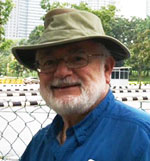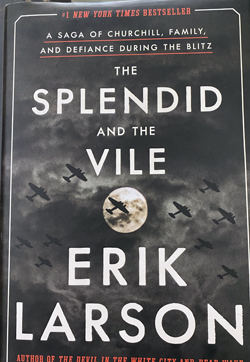The Splendid and the Vile, A Saga of Churchill, Family, and Defiance during the Blitz by Erik Larson, New York: Crown, 2020 ($32)

 RICHMOND, California — A certain obsessiveness guides my nonfiction reading. Where do Jews fit in the story? Where are they overlooked, ignored, or mischaracterized? Is the study well documented? Does the index include thorough references to Jews?
RICHMOND, California — A certain obsessiveness guides my nonfiction reading. Where do Jews fit in the story? Where are they overlooked, ignored, or mischaracterized? Is the study well documented? Does the index include thorough references to Jews?
Winston Churchill is a hero worthy of hagiography and criticism. In a speech in October 1941 before his old school Harrow he uttered the expression “never give in.” It has been invoked by other commencement speakers. The Darkest Hour” in 2017 won Gary Oldman, portraying Prime Minister Churchill, an Academy Award for Best Actor. The film The King’s Speec” received the Academy Award for Best Picture and Colin Firth, portraying King George VI, for Best Actor in 2011.
Churchill also said in November 1942, “I have not become the king’s first minister to preside over the liquidation of the British Empire.” Hence, in the eyes of contemporary politics he was an advocate of colonialism, imperialism, social, political and economic exploitation and domination of Britain’s Asian and African territorial possessions. In June 2020 a statue of Churchill in England had to be boarded up to protect from protesters. Why not commission a modern sculpture to stand nearby of say Ghanaian nationalist Kwame Nkrumah, images of how we have evolved.
I remember an animated discussion about Churchill in the late 1940’s at my grandmother’s home in Richmond, England. My father, voted Labor, my Uncle, Tory. I have vivid childhood memories of big craters in the ground, around the corner from where we lived, left by V1 or V2 rockets. We had giant Guy Fawkes bonfires in it on November 5. Today surviving veterans and elderly civilians of the Greatest Generation are in their mid-nineties.
The Splendid and the Vile by Erik Larson covers the challenges Winston Churchill faced during the first two years of the war, from May 1940 to the end of 1941. Churchill grappled with the Nazi blitzkrieg toppling France and other Allies and the rescue of the British Expeditionary Force from Dunkirk and other locations. Then came the Battle of Britain as Spitfires and Hurricanes, radar and Bletchley Park intelligence interfered with Hermann Göring’s Luftwaffe. The Nazis blitzed London and other English cities for eight months and five days. Blessedly Hitler’s anticipated land invasion never occurred.
Larson presents an unrelenting and gripping 500 pages of political machinations, air raids, ramping up to go on the offensive, and Churchill’s longing for America to join the war. Churchill’s efforts were a warmup ultimately clinched by the Japanese attack on Pearl Harbor on December 7, 1941. Larson’s title, The Splendid and the Vile, does not appear connected to a specific event, or speech, it describes the heights and depths, the valor and depravity, and the “magnificent and terrible” features of total war.
The 30-page Index is necessarily selective. Jews are the only religious group that get a separate entry. It contains direction to anti-Semitism, Göring stealing “ownerless Jewish art,” extermination, persecution, Joseph Goebbels on killing Jews, Rudolf Hess’s hatred of Jews, and British anti-Semitism.
If you rely only on the index you will overlook at least two Jewish references. On page 316 Clementine Churchill, wife of the Prime Minister expressed concern for the living conditions of people who had lost their home in the blitz. She, like the Royal family, went among the people to show concern and bolster morale. Mrs. Churchill visited air raid shelters, the London Underground bomb shelters and other makeshift havens. They were crowded, dirty, with sanitary shortcomings. The excess mortality of the bombings resulted no doubt in fatalities from other causes, just as it has in our own 2020 Pandemic. Clementine noted “The worst conditions she encountered were in Philpot Street, at Whitechapel synagogue, ‘where people were sleeping absolutely opposite the latrines with their feet almost inside the canvas curtains and where the stench was intolerable.’” On page 428 Larson notes “A bomb destroyed a Jewish girls’ club, killing thirty people.”
Larson’s book could well be a reader’s introduction to WWII to be followed by further page turning as the complexity of the Second World War and the legacy of Winston Churchill cannot be confined to one volume, or several volumes. Sir Martin Gilbert, Churchill’s biographer, is credited with scores of books on Churchill, the War, Holocaust and Israel. He wrote Churchill and the Jews: A Long Friendship (2007). Stanford scholar Peter’s Stansky wrote The First Day of the Blitz (2007). If you want to follow up Churchill’s taste for champagne, cigars and dining, in an age of food rationing, Dinner with Churchill: Policy-Making at the Dinner Table (2012) by Cita Stelzer is your cup of tea, a British custom Larson mentioned repeatedly.
Edward Gibbon’s six-volume The History of the Decline and Fall of the Roman Empire published between 1776 and 1789, covers events that occurred 1600 years earlier, is still read. William Shirer published The Rise and Fall of the Third Reich in 1960, 15 years after the war’s end. Our Passover Seder recalls events 3,500 years ago. I wonder if the Greatest Generation will be remembered in a thousand or two thousand years. Because their sacrifices we do not have to contend with a Reich that lasted a thousand years.
*
Pollak, a professor emeritus of history at the University of Nebraska Omaha, and a lawyer, is a correspondent now based in Richmond, California. He may be contacted via oliver.pollak@sdjewishworld.com